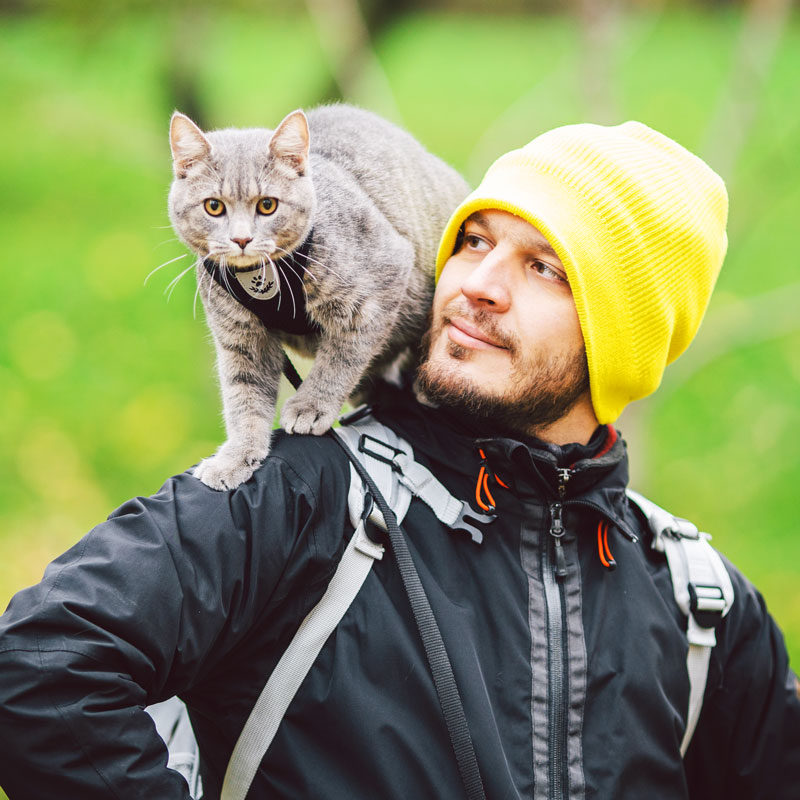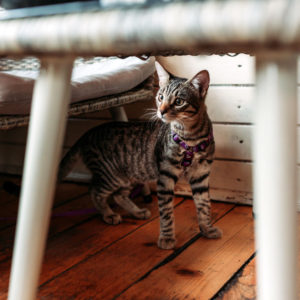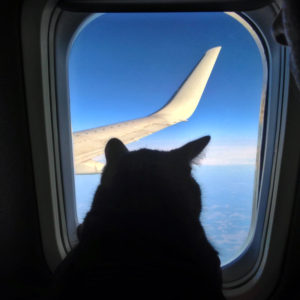
Part 2 – A Drop Trap Master Class with Bryan Kortis, National Programs Director at Neighborhood Cats
August 9, 2022
Habitats for Cats with Mario Arbore, Founder and Owner of Square Paws
August 16, 2022
Contributed by Aaron Smith
When people travel often and want a pet to keep them company, they usually turn to a canine companion. But dogs need a lot of attention and can’t be left alone for long periods. Cats, on the other hand, can be quite independent when they are given adequate food, fresh water, and a litter box. Cats can be great pets to travel within RVs and other life-on-the-road situations. With some training, your cat will be a fun travel buddy! Here’s how to get started.
Kittens Adjust Easier Than Older Cats
If you don’t already have your cat companion, we suggest starting with a very young kitten. The earlier you can get them used to travel, the better. Young cats have an easier time learning new things and adjusting to new experiences. Young cats also have more energy, mobility, and fewer health problems than older cats, which can make things easier when traveling. Though, if you already have an adult cat you want to train to travel with, start way before your travel plans begin with some of the training methods we are about to share with you.
 Leash Train
Leash Train
When you’re traveling and away from the familiarity of home, it’s never a good idea to just let your cat outside without a leash. Your cat might get spooked and not be able to find their way back to you. They could also unknowingly wander into a dangerous situation like a roadway or a place where predatory animals live. Some cats take to the leash right away, while others fight the process altogether. Start leash training your cat slowly by keeping them on the leash for short periods indoors. Eventually, move them into your backyard and then onto new places for more practice.
Make the Carrier a Safe Space
When you’re traveling in any vehicle with a cat, they should be secure inside a carrier so they can’t get under your gas or brake pedals. A carrier with a soft bed for them to lie in and a fold-away or removable door is an ideal choice so it can also be used as a space for them to take cat naps when not traveling. Having them get used to the carrier in this manner will help when it is actually time to pack up and hit the road. Use positive reinforcement like treats and toys inside the carrier to help them associate it with fun times.
Use CBD to Help Them Relax
Even with training and starting with a young cat, their personality type may still make them prone to being nervous when traveling inside a vehicle. A little assistance from pet CBD products can help them mellow out for a long car ride. Cat CBD usually comes in the form of a tincture that can be squirted directly into their mouth or placed on their favorite food or treats.
“CBD oil is a natural and safe method to help pets destress and overcome anxieties. It’s a wonderful solution for owners who want to help their pets relax without the side effects of prescription medications,” states Tim Nasimul, who founded Chill Paws, to help his cat with anxiety.
Start Traveling With Small Trips
Frequent, short trips are the perfect building blocks to work your cat up to longer traveling times. Start by taking them with you for quick jaunts down the road that are close to home. If your cat starts to become distressed, be sure to head back home and try again later. This training should get your cat used to the car and will prepare you for how they will act when your trip is scheduled to start.
Add Cat Essentials to Your Travel List
When traveling with your cat, it’s important to make sure you have everything they’ll need for the trip. Pack things like food, treats, bowls, a leash and harness, emergency contact info, and medications. If your cat doesn’t have any prescription medications, they’ll still need standard feline travel essentials like the aforementioned CBD, motion sickness meds, flea and tick prevention, and healing ointment in case they get a cut or burn.
ID Your Cat
No matter how much training and preparing for your trip you’ve accomplished with your cat, there’s always a chance they might get loose and lost. Make sure you fit them with a standard breakaway cat collar and an ID tag that has your phone number on it. You could also get them microchipped which will serve as a good backup in case they ever lose their collar.
 Give Your Cat Breaks
Give Your Cat Breaks
When you’re out on the road, it’s not always easy to tell whether your cat is hungry or thirsty. Make stops as needed to let them out on the leash, eat, and drink. Eventually, you’ll become familiar with the signs your cat presents to let you know they need something.
Research Your Travel Options
Before you hit the road, you’ll want to plan out where you’re going to stay and how you’re going to get there. Not all pet-friendly hotels allow cats, so call ahead of time to confirm. And, if you’re not traveling in your own vehicle, check with airlines, trains, buses, and ships to make sure they will allow your adventure cat companion aboard.
Molding a cat into the perfect travel companion is not always an easy task, but can be very rewarding for both you and your pet. With a bit of patience and perseverance, you and your cat can be traveling the country and enjoying the outdoors together!
Want more tips for traveling with cats?
Listen to these episodes from the Community Cats Podcast:
- Episode #134: Laura Moss, Founder & Jamie Brooks, Communications at AdventureCats.org
- Episode #318: Jenny Hart, Travel Writer & Cat Mom
- Episode #334: Hasara Lay, Catexplorer
- Episode #430: Emily Hall, Founder & Owner of kittycatgo.com
About Aaron Smith
Aaron is a writer, copy strategist, and consultant who works with several companies and nonprofits. He covers developments in various industries, ranging from health and technology, and helps companies connect with clients. In his free time, Aaron enjoys swimming, swing dancing, and spending time with his three pups: Buddy, Roxy, and Kaya.




